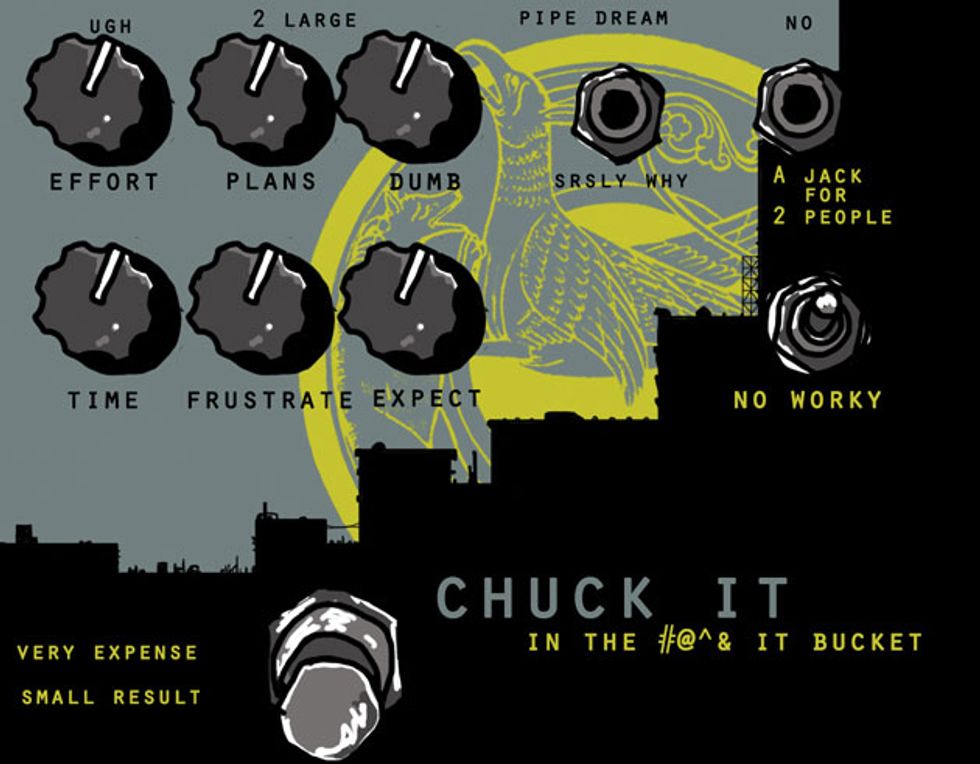The Time: Time to go to the mall.
The Place: Car Guy Magazine’s “coolest family van” three years running, aka Dwarfcraft One.
The Cast: Your old pal—me—and at least three middle-school girls.
The girls were shouting. (They’re always shouting. On a scale from 1 to 10, middle-school girls only have feelings above 9.) I tried to ignore the noise, but the volume was too severe. Eventually they began firing off funny rhymes and sayings they enjoyed. This quickly became my scene, but they weren’t moved by my proud declaration of “tune low, play slow.” But I guess they could tell how dangerously cool I am, because one of my passengers shared something you can only say in front of cool parents.
In a full voice she spoke: “You know what Maya always says … chuck it in the…” Long pause, giggles. Then, in a hushed tone, “fuck-it bucket.”
The van erupted in laughter. Yes! It’s a great rhyme and, as far as I’m concerned, a pretty powerful and healthy line to have at your disposal. I find in art and business, sometimes you just have to chuck it.
We like to think of ourselves as dedicated, hardworking types who don’t let the bumps in the road tear us apart. Of course, lots of people are out there busting their humps and getting great results. I think it’s great to tackle a project with all your might and to see it through. I’m going to let you in on a secret, though. For a variety of reasons, gear companies chuck things. We’ve ditched two circuits and put one on hold this year. Multiply that by almost a decade in this industry and you’ll get an idea of our pedal graveyard.
There are many roads to Abandon Town. For example, it’s pretty tough for me to put my weight behind any distortion circuit anymore. From a musical perspective, I’ve already made or purchased my favorite distortion devices, so it’s hard to get fired up about something that can’t beat what we’ve already got. The business person’s perspective is even harsher. Taking a gander at the latest issue of Real Cool Pedal Guy Magazine, I notice there are just under three billion handmade distortion pedals available. That’s not counting the self-oscillating fuzzes, of which there are roughly 23 million. Business guy does not feel great about trying to sell another one of those. Music guy can’t even get excited about using it. Sorry “neat fuzz,” your next stop is the shelf for old ideas. Maybe I’m pickier than I need to be, but there are more than a few schematics and even prototypes from abandoned drive/fuzz/distortion pedals rattling around my workshop.
A schematic is a great place to leave a project. It’s easy! You put some work in, a few hours in front of the breadboard, but it’s just not working. Hang on to that paper. You might come back to it some day, but probably not. It gets tougher the longer the project goes on. An intense focus, or the more effective “dangerous obsession,” with a project can really gum up the works when it comes to the practicalities of a pedal. We had one of these this year. I was deep into the artwork, front panel design, and circuit design for a pedal from day one. I’m pretty sure I thought about it at night instead of sleeping. As soon as I got to work in the morning, I’d add the features or tweaks I’d imagined earlier. This was gong to be the best pedal that ever did … that one thing.
Yes, I’d found nearly all the pathways. I managed to use mostly parts that were currently available—and an expensive power converter that also required a second circuit board. And an extra-large enclosure. When considering all these factors, it became clear I’d dreamed up the world’s least marketable one-trick pony. And while it was technically not a clipping-style distortion device, eight out of 10 players would hear it and say, “real cool fuzz, bro.”
Ugh. Chuck it in the fuck-it bucket. Music guy was a little sad. This would’ve been a lot of fun to play with. Business guy locked eyes with music guy and did his best Tommy Lee Jones in The Fugitive, responding: “I don’t care.”
At least the visual mockup came in handy for illustrating this article, and I played it pretty close to the vest on social media, so nobody outside the shop is going to be let down. And don’t worry about music guy. He remembers how to patch it up on the modular rig.
I’d be lying if I said I didn’t feel a bit of relief at being able to stop at that point. Ten years in the pedal industry has shown me plenty of disasters, and once I could visualize this one unfolding I was glad to have dodged that bullet. On top of that, we sunk very little money into the project, and did no marketing or building, so I got to skip all that and start on something new and exciting, like modding a Tube Screamer! Has anyone done that yet?
Please don’t read this as an endorsement of “just giving up.” We’ve toiled over pedals for a year-and-a-half, and had great success when they were finally finished. I think it’s a good idea to take a few steps back and consider every aspect of a project a few times during the process. Every once in a while, you might save yourself a real headache with those seven magical words: “Chuck it in the fuck-it bucket.”
P.S. Did you figure out that music guy and business guy are both me?












![Rig Rundown: Russian Circles’ Mike Sullivan [2025]](https://www.premierguitar.com/media-library/youtube.jpg?id=62303631&width=1245&height=700&quality=70&coordinates=0%2C0%2C0%2C0)














